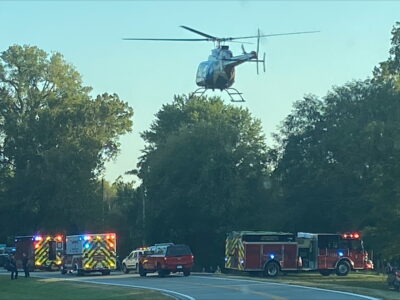Mobile app alerts community members to cardiac emergencies needing CPR, helping patients get help sooner

photo by: Chad Lawhorn/Journal-World
A Lawrence-Douglas County Fire & Medical ambulance is pictured on July 5, 2023.
Community members can support Douglas County fire departments during cardiac emergencies by downloading a mobile app that alerts nearby individuals when someone needs help.
The mobile app, PulsePoint, is a free tool that connects users with real-time emergency alerts in their area. It allows Douglas County residents to assist individuals experiencing cardiac emergencies before professional first responders arrive. Once responders are on the scene, they take over care. The app also helps keep the community informed, encourages quick action, and promotes a safer, more connected community, McKenzi Ezell, chief of staff at Lawrence-Douglas County Fire Medical, said in an email to the Journal-World.
Ezell said in the email that PulsePoint was first launched for Douglas County fire agencies and the community in 2021, and the service was purchased through collaborative efforts between the City of Lawrence and Douglas County. The city funded the one-time set-up cost while the county funds the annual reoccurring costs.
LDCFM has been leading the implementation of the PulsePoint project and has been communicating and collaborating with other county first-responder agencies to reach all corners of the county. The county agencies that utilize PulsePoint are LDCFM, Consolidated Fire District No. 1, Baldwin City Fire, Palmyra Fire, Willow Springs Fire and Eudora Fire EMS.
When 911 is called for a suspected cardiac arrest in a public location, the app sends alerts to nearby users, directing them to the victim’s location and the closest automated external defibrillator. According to the PulsePoint website, the goal is to notify individuals who are within walking distance of the emergency. However, the alert radius can be adjusted based on local needs and response time data. In densely populated areas, a smaller notification radius is typically used, while rural areas may require a wider range due to longer response times.
There are currently 1,670 active monthly users watching LDCFM on the app. CPR certification is highly recommended but not required to download or use PulsePoint. The app offers valuable resources — such as videos and step-by-step instructions — to help users prepare for emergency situations. Ezell said in the last 30 days, LDCFM has reported 23 CPR-needed incidents.
“Even a basic understanding of hands-only CPR can make a critical difference until professional responders arrive,” Ezell said via email.
In addition, LDCFM uses PulsePoint’s Verified Responder feature to provide incident information and alert its crews. While all of the incidents are displayed through the station/radio alerting system, it can be helpful when the information is available at the firefighter’s fingertips, Ezell said. The Verified Responder access gives them the ability to receive all cardiac arrest alerts, whether they happen in public places or in private residences while on/off duty.
Ezell said in the email that LDCFM encourages all county residents and visitors to download the PulsePoint app and follow the department on the app.
“Doing so allows users to see real-time LDCFM incidents, including structure fires, vehicle accidents, technical rescues, and medical emergencies. Each user can customize their alert settings to match their interests,” Ezell said via email.
Legend for PulsePoint app
The app displays various colors and abbreviations for each incident. The abbreviations represent the radio IDs of agency units — such as engines, chief officers, and ambulances — assigned to the incident. The different colors indicate the status of each unit, such as whether they are en route or have already arrived on scene.
For example, unit abbreviations could include M1, which stands for Medic 1. Additionally, E1 is Engine 1 while MIH1 is for Mobile Integrated Health 1. There are also some unique naming conventions that designate the shift or staffing level, such as B1Y, which stands for Battalion 1 Y-Shift.
The different colors and other potential symbols that could accompany an incident in the PulsePoint app, include:

• An orange unit abbreviation with a question mark in front of it means the unit has been dispatched to the incident. If it’s orange without the question mark, it indicates the unit has acknowledged the dispatch — usually by pressing a button at the station.

• A green unit abbreviation means the unit is currently traveling to the incident location.

• A red unit abbreviation means the unit has arrived at the incident scene. If a red caret symbol (^) appears with it, the unit is staying at the scene but is available for dispatch to another incident.

• A blue unit abbreviation indicates that the transporting unit has arrived at the incident’s destination.

• A yellow unit abbreviation means that the unit is currently transporting a patient.

• A gray unit abbreviation means that the unit is no longer assigned to the incident.







